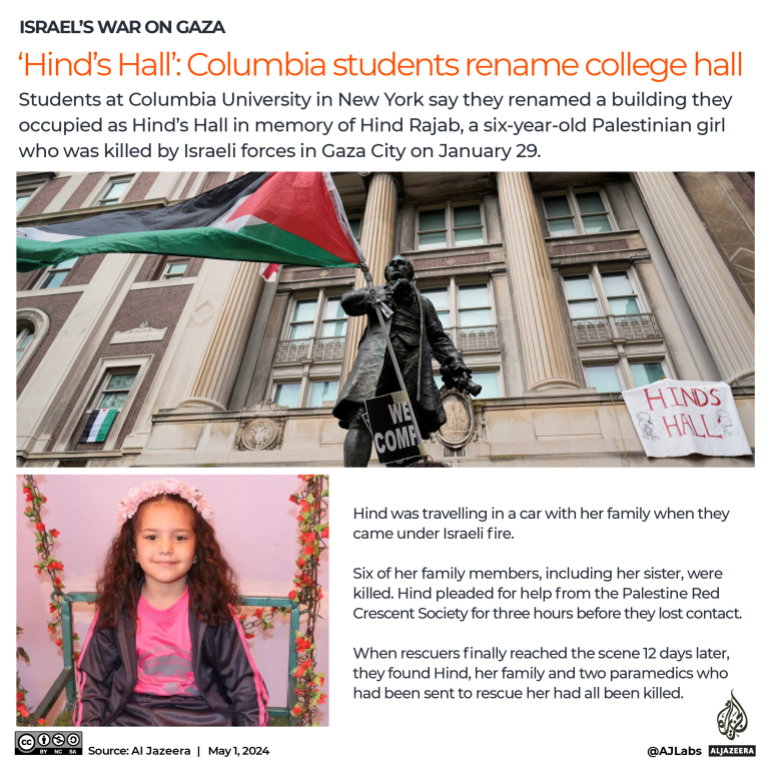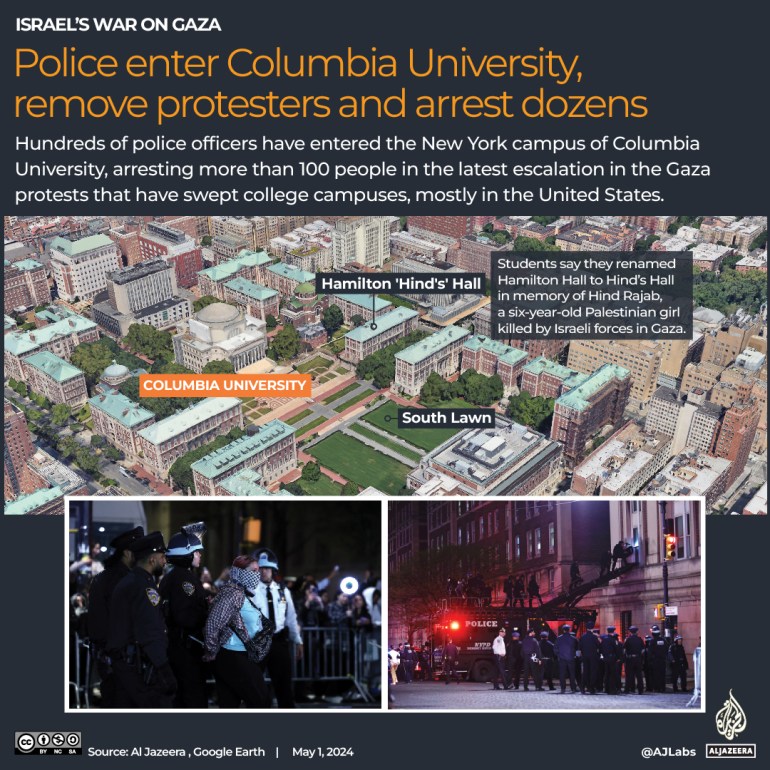Hamilton Hall, the academic building at Columbia University that students protesting against Israel’s war on Gaza occupied early on April 30, has a long history of student protests.
Over the past half-century, students have barricaded themselves there in protest at pivotal moments in history, including the Vietnam War and the growing global momentum against apartheid in South Africa.
Protesters dubbed the building “Mandela Hall” in honour of the South African liberation leader during the 1985 student blockade. Echoing the 1985 protests, students who took over the building on Tuesday renamed it “Hind’s Hall” in honour of six-year-old Hind Rajab, who was killed alongside her family by Israeli forces in Gaza.
On Wednesday morning, police officers entered the campus, taking dozens of people into custody in the latest escalation between student-led, pro-Palestinian protests and law enforcement authorities.
That crackdown too, like the takeover of Hamilton Hall by students, is in keeping with the history of the building as an iconic protest venue at Columbia.

What is Hamilton Hall?
The hall was inaugurated in 1907 as a flagship building and still houses the dean’s office.
“This is a great day for the college,” Dean John Howard Van Amringe said at the time. “Our alma mater has a home of her own — a building more stately and beautiful, as of right it ought to be, more gracious and significant than any other on the grounds of the university.”
An outdoor sculpture of Alexander Hamilton, who became the first treasury secretary of the United States in 1789 and the founder of the US banking system, stands proudly at the entrance. Hamilton is generally depicted as an abolitionist. However, some research suggests his antislavery credentials may have been inflated.
Alongside four department offices — Germanic Languages, Slavic Languages, Classics, and Italian Languages — it houses the Center for Race and Ethnicity.
A renovation that began in 2000 brought about a new Center for the Core Curriculum, home to the Literature Humanities, Contemporary Civilisation, Music Humanities, Art Humanities and Major Cultures departments.
When have Columbia students occupied Hamilton Hall before?
1968: Vietnam protests
In April 1968, Hamilton Hall was the first of five buildings to be taken over by students protesting against the Vietnam War.
Demonstrators barricaded themselves and prevented acting dean Henry Coleman from leaving his office for one night.
By April 30, a week after the protest started, police officers cracked down on the protesters, entering the building through underground tunnels and forcefully clearing the students.
More than 700 people were arrested, one of the largest mass detentions in New York City history. At least 148 people were injured as some were hit with nightsticks and dragged out, according to the student newspaper.
The protests resulted in the university cutting ties with a Pentagon institute doing research for the Vietnam War and led to reforms favouring student activism.
1972: Antiwar protests
Protests resumed on campus in the spring of 1972, when the administration of Richard Nixon expanded the US military’s bombing campaign in Vietnam.
Demonstrators stormed into a closed meeting of the Columbia University Senate, forcing its suspension, after the management had summoned the police to take action against peaceful rallies.
The blockade of several campuses ended after police in riot gear stormed the compound to evict demonstrators.

1985: Anti-apartheid protests
A gathering of seven students that began on April 4 around the entrance of Hamilton Hall morphed into a mass movement that lasted for 21 days.
At that time, about one-third of the university’s endowments were invested in firms doing business in South Africa.
“America is not always right, but we have the right to protest for the right,” civil rights activist Jesse Jackson told some 5,000 students on the steps of Hamilton. “When the nation of democracy becomes South Africa’s number one trading partner, we’re wrong, this is wrong.”
On October 7, about five months after the protests, Columbia became the first major US university to fully divest from South Africa. Many others would follow.
1992: One-day blockade
In 1992, students blockaded Hamilton Hall to halt Columbia’s plans to demolish the Audubon Theater and Ballroom, where Malcolm X was assassinated in 1965, and replace it with a modern biomedical research complex.
Malcolm X, one of the most important Black figures during the civil rights movement, was assassinated on February 21, 1965, while delivering a speech at the Audubon Ballroom, which then became a major landmark to New York Hispanic and African Americans. After Malcolm X’s shooting, the venue was forced to shut down and the law was abandoned for several years.
Columbia, the largest private landowner in New York City, bought the Audobon Ballroom in the 1980s. In 1989, the university struck an agreement with city authorities to demolish the Audobon facility and build a biotech research centre there.
Amid calls for the ballroom to be preserved, Columbia eventually agreed to a compromise — only a part of the historical venue would be demolished. However, student protesters opposed the demolition of the building.
The blockade lasted six hours: three students were suspended, and 45 others faced disciplinary action.
1996: Ethnic studies department
About 100 protesters occupied Hamilton Hall for about four days in 1996 to demand the creation of an ethnic studies department at Columbia.
The university agreed to provide a physical space for Asian and Hispanic studies programmes and inaugurated the Center for the Study of Ethnicity and Race three years later.

